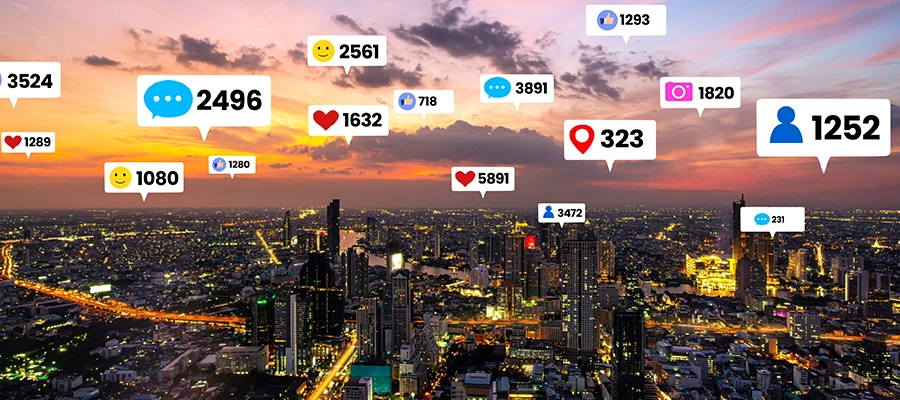Unveiling the Power of Social Media Advertising
In the fast-paced digital landscape, where attention spans are shrinking, and competition is fierce, businesses are continuously seeking ways to captivate their audiences. Social media advertising is at the forefront of this battle for attention – a realm that holds promises of immense reach, engagement, and conversion. In a world dominated by ever-evolving algorithms and user behaviors, understanding the nuances of social media advertising is crucial, especially for B2B and B2C companies alike.
| Time is a precious commodity. So, it’s significant that the average person globally spends a considerable portion of their day—about 145 minutes—on social media. Interestingly, Indians, on average, spend about 141.6 minutes on social media daily.
To put this into perspective, if the average person maintained this usage over an average life span of 73 years, the end result is an astonishing 5.7 years spent on social media platforms. For brands, these numbers highlight the reach and potential of an effective social media strategy. Source: Forbes |
"Google it!" has become a much-used phrase in modern times, underscoring the significance of search engine rankings. There's a joke that the second page of Google is the ideal place to hide a secret, emphasizing the importance of high rankings. Beyond endeavors like blog updates and SEO, maintaining an active presence on social media is crucial. Well-established brands understand this and prioritize social media engagement, enhancing credibility and fostering trust. Elevating your presence on social media can yield an upward thrust in search engine rankings, consequently amplifying web traffic to your digital domain.
This evolution of social media to better mirror the demographics of the broader overall population emphasizes the importance of age-differentiated strategies when planning out social media campaigns.
Please read this blog to learn about social media marketing plans and how to infuse them into your digital marketing strategies.
The Landscape of B2B and B2C Social Media Advertising: A Comparative Overview
Social media marketing strategies employed by B2B and B2C companies unveil distinct approaches shaped by their unique goals and audience dynamics. This comparative analysis delves into the plans and challenges faced by both, shedding light on the divergent paths each treads to captivate their respective markets.
B2B Companies: Pain Points
Understanding the pain points is key to creating the right solutions.
Longer Sales Cycles
B2B companies often grapple with extended sales cycles, requiring consistent nurturing and engagement over time. While promoting their solutions online, these companies must address this challenge by developing content that educates and guides potential clients throughout the decision-making process. Building trust through informative webinars, case studies, and thought leadership content can help accelerate these prolonged sales journeys.
Targeting Niche Audiences
B2B enterprises frequently cater to specific industry niches or professional roles, making accurate audience targeting paramount. When promoting solutions online, precision in reaching the right decision-makers is crucial. B2B companies must leverage advanced targeting features on social media platforms to ensure their content reaches professionals who hold the authority to initiate business transactions.
Conveying Complex Value Propositions
The intricate and multifaceted nature of B2B solutions often results in complex value propositions that can be challenging to convey concisely. In online promotion, B2B entities must invest in clear and compelling content strategies that simplify their offerings. Explainer videos, infographics, and engaging storytelling can help distill intricate concepts into easily digestible formats, aiding potential clients in understanding the tangible benefits of their solutions.
B2B Companies: Social Media Marketing Strategies:
In order to solve the above-mentioned challenges, do take a look at the below strategies that you may embrace while leveraging your social media platforms.
Thought Leadership Content:
Position your company as an industry authority by sharing informative articles, whitepapers, and case studies. This builds credibility and attracts decision-makers.
Example - Tata Consultancy Services (TCS):
TCS, a leading IT services and consulting company in India, consistently shares thought leadership content on its social media platforms. They publish informative articles, research papers, and whitepapers on emerging technologies, digital transformation, and industry trends. By sharing valuable insights, TCS positions itself as an authority in the technology and consulting space, attracting decision-makers looking for cutting-edge solutions.
Educational Webinars and Videos
Host webinars or video series that offer valuable insights and solutions related to your industry. This showcases your expertise and fosters engagement.
Example - Infosys:
Infosys, a global IT services company, conducts educational webinars and video series that delve into complex tech topics. Their webinars cover subjects like artificial intelligence, blockchain, and cloud computing, offering practical insights and solutions. By hosting such webinars, Infosys showcases its expertise and fosters engagement among industry professionals seeking to deepen their understanding of these technologies.
LinkedIn Networking
Leverage LinkedIn to connect with key professionals, participate in industry groups, and share thought-provoking content to establish strong B2B relationships.
Example - Accenture India:
Accenture India actively engages on LinkedIn by sharing insightful business trends, leadership, and innovation content. They also participate in industry groups, initiating discussions on crucial topics. This strategy allows them to connect with key professionals, establish themselves as thought leaders, and nurture relationships that could lead to potential partnerships.
Targeted Content Marketing
Create content tailored to the specific pain points of your B2B audience. Address challenges they face and offer practical solutions through blog posts, videos, and ebooks.
Example - Wipro:
Wipro, an IT services company, tailors its content marketing to address the specific pain points of different industries. They create videos, blog posts, and ebooks focusing on challenges faced by sectors like healthcare, finance, and retail. By offering practical solutions, Wipro demonstrates an understanding of industry nuances and positions itself as a reliable partner for addressing those challenges.
Retargeting for Conversion
Implement retargeting campaigns to remind decision-makers of your solution after they've visited your website, encouraging them to convert.
Example - Zoho Corporation:
Zoho, a software company, employs retargeting strategies effectively. After users visit their website, Zoho's ads follow them on social media platforms, reminding them of their software solutions for various business needs. This approach keeps Zoho's offerings top-of-mind for decision-makers, increasing the likelihood of conversions.
Influencer Collaborations
Partner with industry influencers or experts to co-create content, provide endorsements, and expand your reach within your target B2B audience.
Example - Deloitte India:
Deloitte collaborates with industry experts and influencers to co-create content. They might partner with a respected economist to discuss economic trends or with a tech influencer to explore digital disruption. By leveraging the reach and credibility of these influencers, Deloitte expands its audience and strengthens its position as a thought leader.
Personalized Email Marketing
Integrate your social media efforts with email marketing, delivering personalized content and nurturing leads through the sales funnel.
Example - HCL Technologies:
HCL Technologies integrates their social media efforts with personalized email marketing campaigns. After users engage with their social media content, they receive tailored emails with more in-depth insights, case studies, and solutions related to their interests. This approach nurtures leads through the sales funnel and enhances the overall customer experience.

B2C Companies: Pain points
Understanding the pain points is key to creating the right solutions.
Rapid Trend Changes
For B2C companies, staying attuned to ever-evolving trends is essential, yet challenging. When promoting solutions online, they must swiftly adapt to the latest fads to remain relevant and resonate with their target audience. Brands like Myntra, an Indian fashion e-commerce platform, tackle this by consistently featuring trending styles, collaborating with fashion influencers, and curating collections that reflect the current fashion landscape.
Diverse Audience Segments
B2C companies often cater to diverse consumer segments with varying preferences and needs. When promoting solutions online, they face the task of crafting content that appeals to these distinct groups. Amazon India effectively addresses this challenge by offering personalized recommendations based on users' browsing and purchase history, tailoring their online shopping experience to individual preferences.
Maintaining Authenticity
In a world of influencer endorsements and curated content, maintaining authenticity is a concern for B2C brands. While promoting solutions online, they must strike a balance between promotional content and genuine interactions. Brands like Amul, an iconic Indian dairy cooperative, uphold authenticity by consistently sharing witty and relatable posts that reflect their brand identity, resonating with consumers on a personal level.
| Twitter (42.90% penetration), LinkedIn (35.7% penetration), Moj (29.50% penetration), a short video community created locally, and Pinterest (29% penetration) are a few additional social networking platforms that are well-liked in India.
Source: Forbes |
B2C Companies: Social Media Marketing Strategies:
In order to solve the above-mentioned challenges, take a look at the social media marketing plans you may embrace while leveraging your social media platforms.
Visual Storytelling
Use platforms like Instagram and TikTok to tell your brand story visually. Share user-generated content, behind-the-scenes peeks, and product demonstrations.
Example - Chumbak:
Chumbak, an Indian lifestyle brand, excels in visual storytelling through platforms like Instagram. They share colorful and whimsical posts that reflect their brand's vibrant identity. They go beyond showcasing products, sharing behind-the-scenes glimpses of their design process and the stories that inspired each collection. Chumbak creates an engaging and relatable brand story that resonates with its audience by blending visuals with narratives.
Influencer Marketing
Collaborate with social media influencers who align with your brand values and resonate with your target consumer audience. Their endorsements can drive consumer interest.
Example - Nykaa:
Nykaa, a popular beauty and cosmetics retailer, leverages influencer marketing to great effect. They collaborate with beauty influencers to review and demonstrate their products, reaching a wider audience of makeup enthusiasts. By aligning with influencers who share their passion for beauty, Nykaa garners authentic endorsements that drive consumer interest and credibility.
User-Generated Content Campaigns
Encourage customers to share their experiences with your product/service, showcasing real-life benefits and building trust among potential buyers.
Example - GoPro India:
GoPro, known for its action cameras, encourages users to share their adventures and experiences using their products. They curate and showcase user-generated content that captures stunning landscapes, adrenaline-pumping activities, and heartfelt moments. By featuring real users' content, GoPro builds a sense of community, authenticity, and trust among potential buyers.
Limited-Time Offers and Flash Sales
Create a sense of urgency with time-sensitive promotions, appealing to consumers' fear of missing out (FOMO) and driving quick purchases.
Example - Flipkart:
Flipkart, one of India's largest e-commerce platforms, regularly runs limited-time offers and flash sales on its social media channels. They create buzz and urgency by promoting time-sensitive deals and enticing consumers with significant discounts. This strategy taps into consumers' fear of missing out (FOMO), driving quick purchases during the sale window.
Engaging Contests and Giveaways
Run interactive contests that require users to engage with your content, share it, or tag friends for a chance to win prizes, boosting brand visibility.
Example - Swiggy:
Swiggy, a leading food delivery platform, frequently runs engaging contests on social media. They ask users to share their creative food-related stories, tag friends, or participate in interactive challenges. These contests not only boost brand visibility but also encourage user engagement, fostering a sense of fun and community around the brand.
Lifestyle Branding
Curate content that resonates with your target consumers' lifestyles and aspirations. Showcase how your product/service seamlessly fits into their lives.
Example - OnePlus India:
OnePlus, a smartphone brand, aligns with users' aspirations by showcasing their products in various lifestyle scenarios. They share images of their sleek smartphones seamlessly integrated into users' daily lives, whether it's capturing scenic views or attending events. This lifestyle-centric approach underscores how their products enhance consumers' experiences.
Emotional Advertising
Tap into consumers' emotions by using heartfelt stories, inspiring messages, or relatable content that triggers emotional connections with your brand.
Example - Cadbury India:
Cadbury, known for its emotional advertisements, taps into consumers' emotions with heartwarming stories. Their campaigns often revolve around relationships, celebrations, and nostalgia, creating strong emotional connections with their audience. Cadbury builds a deep bond between consumers and the brand by triggering relatable emotions.
eCommerce Integration
Utilize shoppable posts on platforms like Instagram and Facebook to provide a seamless shopping experience directly from your social media content.
Example - Amazon India:
Amazon India capitalizes on e-commerce integration with shoppable posts on Instagram. They showcase products and allow users to explore and purchase directly through the platform. By simplifying the shopping journey and reducing the steps between discovery and purchase, Amazon enhances the convenience and seamlessness of online shopping.

Tips to Master Social Media Advertising
- Audience Research and Targeting: Understand demographics, behaviors, and pain points to create tailored content.
- Engaging Content Creation: Craft visually appealing and informative content that resonates with the audience.
- Consistency and Timing: Maintain a consistent posting schedule and leverage insights to identify optimal posting times.
- Storytelling: Narrate compelling stories that connect emotionally with the audience.
- Interactive Content: Polls, quizzes, and contests to boost engagement and gather insights.
- Crafting Effective Social Media Posts: Types and Call-to-Actions (CTAs)
- Educational Posts: Share industry insights, statistics, and how-to guides.
- Behind-the-Scenes: Offer a glimpse into company culture and processes.
- User-Generated Content: Showcase customer experiences to build trust.
- Promotions and Offers: Provide exclusive deals to encourage conversions.
- CTAs: 'Learn More', 'Shop Now', 'Sign Up', 'Download', 'Request Demo'.
- Leveraging Downloadable Assets and Platforms
Let’s take a look at a few content assets that can help you leverage the social media platforms.
Ebooks and Whitepapers: Ideal for B2B companies to showcase expertise.
Infographics and Visual Guides: Engaging content for both B2B and B2C audiences.
Webinars and Video Series: In-depth insights and tutorials for B2B segments
Distinguishing B2B and B2C Social Media Advertising
| B2B | B2C | |
| Target Audience | Niche professionals | Mass consumers |
| Content Tone | Professional, educational | Lifestyle-focussed, emotional |
| Sales process | Longer sales cycle | Impulsive purchasing decisions |
Is Social Media Advertising Really Worth It?
The question of whether social media advertising is truly worth it depends on various factors, including your business goals, target audience, industry, and the strategies you employ. While there's no one-size-fits-all answer, there are compelling reasons that indicate the value of social media advertising:
- Vast Reach: Social media platforms have billions of active users, providing an unparalleled opportunity to reach a wide and diverse audience. This reach can be especially beneficial for increasing brand awareness and expanding your customer base.
- Targeted Advertising: Social media platforms offer advanced targeting options that allow you to reach specific demographics, interests, behaviors, and even job titles in the case of B2B advertising. This precision targeting can result in higher engagement and conversions.
- Cost-Effective: Social media advertising can be cost-effective, especially when compared to traditional advertising methods. You have the flexibility to set budgets, control spending, and optimize campaigns based on real-time data.
- Engagement and Interaction: Social media facilitates direct engagement with your audience through comments, likes, shares, and direct messages. This interaction can lead to building stronger relationships, brand loyalty, and even valuable user-generated content.
- Data Analytics: Social media platforms provide detailed analytics that give you insights into the performance of your campaigns. You can measure clicks, conversions, engagement rates, and more, allowing you to make data-driven decisions.
- Flexibility and Creativity: Social media platforms support a variety of content formats, from images and videos to interactive polls and stories. This allows you to showcase your products or services creatively and adapt your social media marketing strategies as trends evolve.
- Lead Generation and Conversions: Social media advertising can drive traffic to your website, landing pages, or online store, increasing your chances of lead generation and conversions. You can guide users through the customer journey effectively.
- Retargeting Opportunities: Social media platforms offer retargeting options, allowing you to reconnect with users who have shown interest in your products or services but haven't converted yet. This can lead to higher conversion rates.
- Competitor Presence: If your competitors are actively engaging in social media advertising, not participating could put you at a disadvantage. It's important to have a presence where your target audience spends time.
However, it's crucial to recognize that social media advertising success isn't guaranteed. It requires careful planning, consistent monitoring, and adaptation based on data and insights. Additionally, businesses in certain industries, such as B2B, might have longer sales cycles, making the impact of social media advertising harder to quantify immediately.
Ultimately, the worth of social media advertising depends on your ability to align your strategies with your business objectives, create engaging content, and adapt to the ever-changing digital landscape. Regular evaluation of your campaigns' performance will help you determine if social media advertising is delivering the desired results and if it's a worthwhile investment for your specific business.
Navigating the Social Media Advertising Landscape
In the dynamic realm of social media advertising, the worthiness of your investment lies in the strategies you employ. Tailoring your approach to the specific needs of your B2B or B2C company, while embracing the power of engaging content and targeted CTAs can indeed lead to remarkable business growth. By understanding the nuances and staying attuned to the ever-changing digital landscape, you can harness the true potential of social media advertising and steer your business towards success.
Connect with us to connect with your target audience on the platforms that they are known to be on. Let’s leverage the digital landscape to boost your social media presence.


